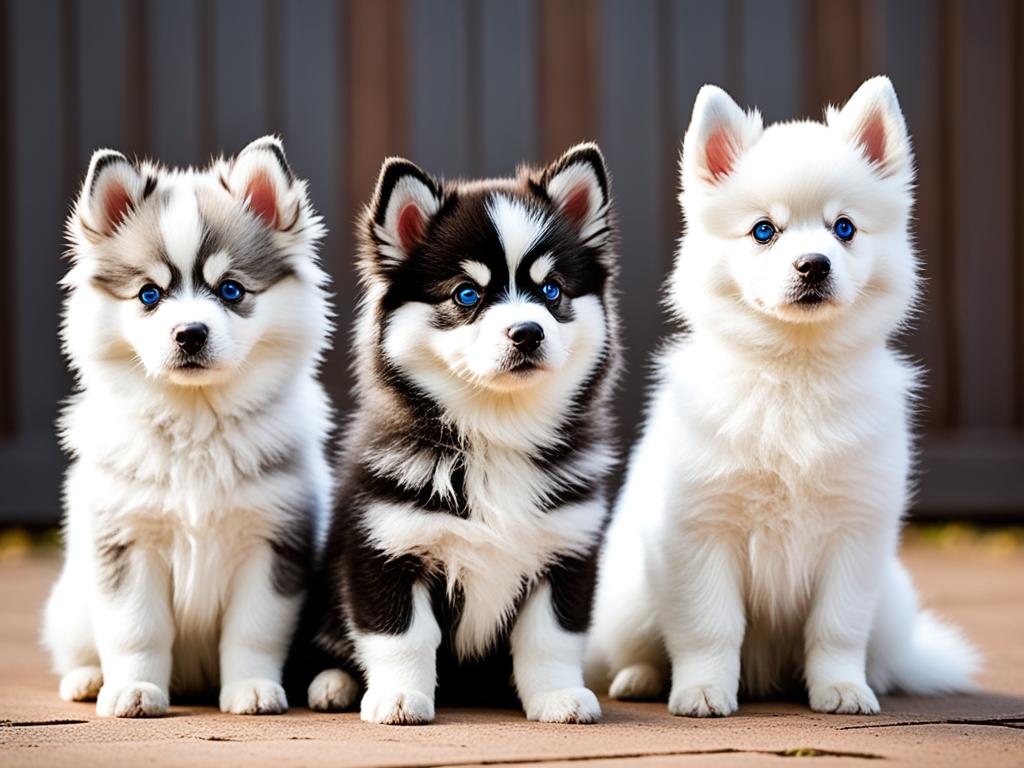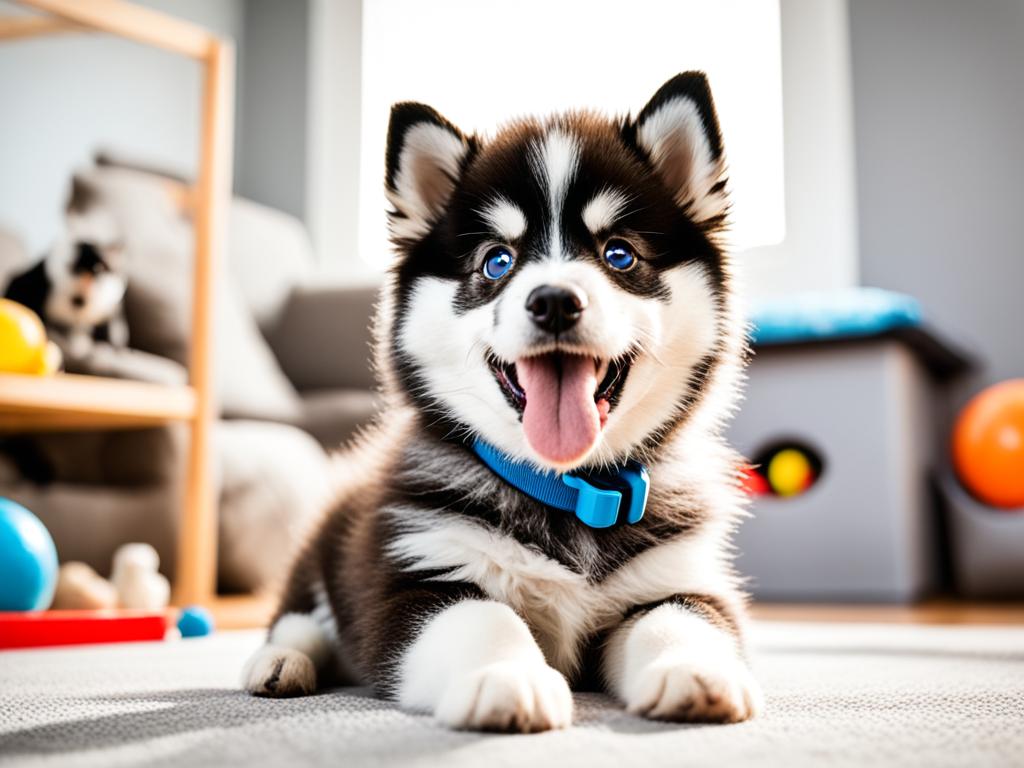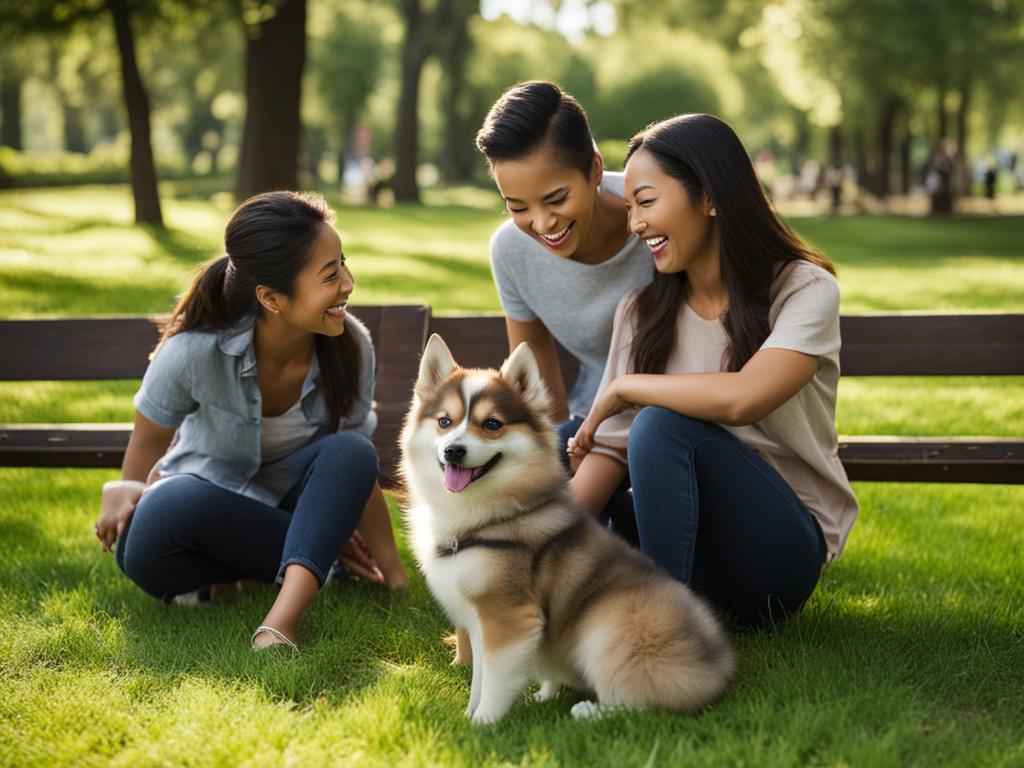Did you know that the Pomsky, a popular designer breed, is a mix between a Siberian Husky and a Pomeranian? This unexpected combination results in an adorable and intelligent companion that has captured the hearts of many dog lovers.
If you’re considering adopting a Pomsky, it’s essential to understand the adoption process and the unique characteristics of this hybrid breed. From their appearance to their temperament, there are important factors to consider before bringing a furry Pomsky friend into your home.
Key Takeaways:
- The Pomsky is a mix between a Siberian Husky and a Pomeranian.
- Adopting a Pomsky involves understanding their unique characteristics.
- Pomskies can vary in appearance and temperament.
- Their coat requires regular grooming and maintenance.
- Pomskies are intelligent and need proper socialization and training.
The Origins of The Pomsky Mix: The Parents
The Pomsky is a unique designer breed that is created through artificial insemination using the Siberian Husky and Pomeranian as the parent breeds. By combining the characteristics of these two breeds, the Pomsky inherits a fascinating blend of traits that make them truly one-of-a-kind.
Let’s take a closer look at the parent breeds:
The Siberian Husky
The Siberian Husky is a medium-sized, athletic breed that is renowned for its striking appearance and exceptional endurance. They have a strong, muscular build and a notably dense double coat that provides insulation from cold weather. With their piercing blue or multicolored eyes, Huskies possess an alluring and captivating gaze. Their friendly and outgoing nature, coupled with their intelligence, makes them beloved family pets.
The Pomeranian
The Pomeranian, in contrast, is a small and fluffy breed with a lively and extroverted personality. Despite their petite size, Pomeranians are known for their confidence and protective instincts. They have an abundant, plush coat that comes in a variety of colors and patterns. Pomeranians are spirited, eager to please, and highly trainable.
When the Siberian Husky and Pomeranian come together to create the Pomsky, their diverse qualities blend harmoniously, resulting in an extraordinary companion with a unique set of characteristics.
| Parent Breeds | Pomsky |
|---|---|
| Size | Varies, but generally small to medium-sized, with some variation within the breed. |
| Coat | Can vary in length, texture, and color, often resembling the Siberian Husky’s double coat. |
| Temperament | Intelligent, playful, and affectionate. |
| Exercise Needs | High, requiring regular exercise and mental stimulation. |
| Training | Trainable, but may have a touch of stubbornness. |
| Lifespan | 12-16 years. |
The Pomsky’s physical appearance, temperament, and exercise needs can vary within the breed. It’s important to research and understand the Pomsky breed characteristics to ensure it aligns with your lifestyle and preferences before deciding to adopt one.
Now that we’ve explored the origins and parent breeds of the Pomsky, let’s move on to the next section to delve deeper into their charming appearance!
The Appearance of The Pomsky
When it comes to the appearance of Pomskies, their first-generation designer breed status means that they can vary in their characteristics. As a cross between Siberian Huskies and Pomeranians, Pomskies often exhibit a mix of traits from both parent breeds. Their unique look is captivating and mystical.
Most Pomskies inherit the marbling coat pattern seen in Siberian Huskies, with colors ranging from black, grey, to reddish-brown. Their coats are typically dense and fluffy, requiring regular grooming to keep them in optimal condition.
In addition to their striking coats, Pomskies have large ears that add to their adorable appeal. Their eyes are often expressive and bright, drawing attention to their playful and mischievous nature.
It’s important to note that while there are common characteristics among Pomskies, the appearance of each individual can differ even within the same litter. This adds an element of excitement and surprise when adopting a Pomsky puppy.

| Characteristic | Description |
|---|---|
| Coat Color | Black, grey, or reddish-brown |
| Coat Type | Dense, double coat that requires regular grooming |
| Ears | Large and prominent, adding to their cute appearance |
| Eyes | Expressive and bright |
The Pomsky Coat
The Pomsky breed characteristics include a dense and double coat that requires regular grooming and maintenance to keep it in good condition. This coat is one of the distinguishing features of the Pomsky and contributes to their adorable appearance.
The Pomsky’s coat consists of an undercoat and a topcoat. The undercoat is soft and helps to insulate the dog, keeping them warm in colder temperatures. The topcoat is longer and serves as protection from the elements.
Regular brushing is essential for Pomsky owners to prevent excessive shedding. Due to their double coat, Pomskies can shed quite heavily, especially during seasonal coat changes. Brushing their coat helps to remove loose hair and reduces the amount of shedding around the house.
The length and texture of the Pomsky’s coat can vary depending on the individual dog. Some Pomskies may have a shorter and smoother coat resembling their Pomeranian parent, while others may have a longer and more textured coat similar to their Husky parent.
To maintain the Pomsky’s coat, it is recommended to brush them at least once or twice a week. This not only helps to control shedding but also keeps their coat clean and free from mats or tangles. Additionally, regular brushing allows for bonding time between the Pomsky and their owner, enhancing the relationship between them.
In addition to brushing, Pomsky owners should also consider regular grooming activities such as bathing, nail trimming, and ear cleaning. These grooming routines help to keep the Pomsky clean, comfortable, and healthy.
Pomsky Adoption Requirements
Before adopting a Pomsky, it’s important to understand the specific requirements associated with their coat. Here are a few adoption requirements to consider:
- Commitment to regular brushing and grooming
- Ability to provide a suitable living environment for a dog with a double coat
- Understanding the shedding patterns and being prepared for regular cleaning
- Willingness to invest time and effort in maintaining the Pomsky’s coat
- Access to professional grooming services when necessary
By meeting these adoption requirements, you can ensure that your Pomsky’s coat remains healthy and beautiful, enhancing their overall well-being and appearance.
The Temperament of The Pomsky
Pomskies are known for their intelligence, playfulness, and desire for attention. They inherit these traits from both the Siberian Husky and the Pomeranian parent breeds. These small and energetic dogs thrive on mental stimulation and love engaging in activities with their owners.
One unique characteristic of Pomskies is their talkative nature. They have a wide range of vocalizations and can communicate using a vocabulary of sounds that are distinct to their breed. This expressive behavior is one of the endearing qualities that make Pomskies popular among dog enthusiasts.
However, it is essential to note that socialization and training are crucial aspects of Pomsky ownership. Proper socialization from an early age helps them interact well with strangers, children, and other pets. It also prevents separation anxiety and excessive barking. Consistent training is necessary to establish boundaries and ensure they are well-behaved members of the family.
Pomsky Adoption Tips
When considering adoption, it is vital to spend time with the individual puppy before making a decision. This allows you to observe their unique personality and temperament. Some Pomskies may have a stronger Husky influence and exhibit traits like independence and a high prey drive, while others may have more of the Pomeranian’s affectionate and loyal nature.
In addition to spending time with the puppy, it is essential to seek guidance from experienced Pomsky breeders or trainers. They can provide valuable insights into the breed and offer advice on training and managing their specific needs.
Before bringing a Pomsky home, ensure you have a secure and well-prepared environment to meet their exercise needs. Regular mental and physical stimulation through play, training sessions, and walks will keep them happy and prevent boredom-related behaviors.
Remember, Pomskies are highly trainable and thrive on positive reinforcement techniques. Consistency, patience, and the use of rewards-based training methods will yield the best results.
| Temperament Traits | Description |
|---|---|
| Intelligence | Pomskies are intelligent and eager to learn, making them highly trainable. They excel in activities that challenge their minds and enjoy problem-solving tasks. |
| Playfulness | Pomskies have a playful nature and love engaging in interactive playtime. They enjoy games, toys, and activities that keep them mentally and physically stimulated. |
| Attention-Seeking | Pomskies thrive on attention and enjoy being the center of their owner’s world. They form strong bonds with their families and may become anxious or exhibit destructive behavior if left alone for extended periods. |
| Talkative | Pomskies have a unique vocal repertoire and can be quite talkative. They use various sounds to communicate their emotions, needs, and desires. |
| Sociability | Pomskies benefit from early socialization to develop good social skills. They can be friendly and affectionate towards family members, children, and other pets when properly introduced and trained. |
The Statistical Lowdown on the Pomsky
When considering adopting a Pomsky, it is important to understand the breed’s specific requirements and characteristics. Here is a statistical overview that will help you make an informed decision:
| Statistic | Details |
|---|---|
| Average Lifespan | 12-16 years |
| Weight Range | 10-35 pounds |
| Height Range | 10-15 inches |
| Common Coat Colors |
|
These statistics provide valuable insights into what to expect when adopting a Pomsky. Their lifespan of 12-16 years ensures that they can be a long-term companion. However, it is important to note that individual Pomskies may vary within these ranges and may exhibit different characteristics based on their specific lineage.
Image:

Considering the Pomsky’s range in size and weight, it is crucial to ensure that your living space can accommodate their needs. The specific coat colors mentioned, including black, grey, and reddish-brown, are commonly seen in Pomskies. However, it is essential to remember that coat colors can vary within individual puppies and may not always follow these general categories.
Preparing for Your Pomsky: Dog-Proofing and Training
Before bringing a Pomsky home, it is essential to dog-proof the house and create a safe and welcoming environment for the puppy. This will help ensure the Pomsky’s safety and prevent any accidents or injuries. Here are some important steps to take:
Dog-Proofing Your Home
Pomskies are curious and energetic, so it’s important to remove any potential hazards from your home. Here’s a checklist to help you dog-proof your home:
- Secure cabinets and drawers to prevent the puppy from accessing harmful substances.
- Keep small objects, electrical cords, and toxic plants out of reach.
- Use baby gates to block off restricted areas.
- Secure trash cans with lids to prevent the puppy from getting into them.
- Remove or cover any exposed wires or cables.
Creating a Designated Dog Area
Having a designated area for your Pomsky will help them feel comfortable and secure. Set up a space with the following items:
- Food and water bowls
- A comfortable bed or crate
- Toys and chew bones
- A blanket or familiar item from the previous home
Training and Socialization
Training and socializing your Pomsky from an early age is crucial for their development and well-being. Here are some training tips:
- Start with basic commands like sit, stay, and come.
- Use positive reinforcement techniques, such as treats and praise.
- Enroll your Pomsky in obedience classes to learn proper behavior and socialize with other dogs.
- Expose your Pomsky to different environments, people, and animals to prevent fear or aggression.
By dog-proofing your home, creating a designated dog area, and providing consistent training and socialization, you can help your Pomsky adjust to their new home and develop good behavior habits. Remember, patience and consistency are key in the training process.

| Training Tips for Your Pomsky | Socialization Techniques |
|---|---|
| 1. Start with basic commands like sit, stay, and come. | 1. Expose your Pomsky to different environments, people, and animals. |
| 2. Use positive reinforcement techniques, such as treats and praise. | 2. Enroll your Pomsky in obedience classes to socialize with other dogs. |
| 3. Be patient and consistent in your training sessions. | 3. Allow your Pomsky to interact with friendly and well-behaved dogs. |
| 4. Seek professional help if needed. | 4. Introduce your Pomsky to new experiences gradually. |
Bringing Your Pomsky Home: First Steps and the Importance of Routine
When you finally bring your adorable Pomsky puppy home, it’s essential to be well-prepared and have a clear plan in place. Ensuring a smooth transition will help your new furry friend feel safe and secure in their new environment. Here are some important first steps to take and the significance of establishing a routine:
1. Have Your ID and Contact Information Ready
Before bringing your Pomsky home, make sure you have your identification and contact information readily available. This includes your name, address, and phone number. It’s crucial in case your puppy gets lost, and someone needs to contact you.
2. Ensure Safe Transport for Your Puppy
Pomskies are small and delicate, so it’s vital to ensure their safety during transport. Use an appropriate-sized crate or carrier that provides enough space for your puppy to sit, stand, and turn around comfortably. Secure the crate in your vehicle, ensuring it doesn’t move around during the journey.
3. Establish a Routine from the Beginning
Establishing a routine is crucial for your Pomsky’s adjustment and training. Dogs thrive in an environment with structure and predictability. Set consistent times for meals, walks, playtime, and potty breaks. This routine will help your puppy feel secure and understand what is expected of them.
4. Show the Puppy Where to Go to the Bathroom
As soon as you bring your Pomsky home, it’s essential to show them where to go to the bathroom. Designate a specific area in your yard or use pee pads indoors if you’re planning on indoor training. Take your puppy to this designated spot consistently, rewarding them with praise and treats when they eliminate in the right place.
5. Introduce Them to Their Food and Sleeping Areas
Show your Pomsky their designated food and water bowls, as well as their sleeping area. Consistency is key, so choose an appropriate spot for these areas and stick to it. Introducing your puppy to their space will help them feel secure and build a sense of belonging in their new home.

Establishing these first steps and implementing a routine from day one will not only help your Pomsky adjust quickly but also set a solid foundation for training and behavior. Having a structured environment will make your puppy feel safe, loved, and well-cared for.
The First Month with Your Pomsky: Training and Encouraging Good Behavior
Welcoming a new Pomsky puppy into your home is an exciting experience. The first month is crucial for establishing a strong foundation for training and encouraging good behavior. By following a few key tips, you can set your Pomsky up for success and ensure a smooth transition into their new environment.
1. Consistent Training and Rewards
Consistency is key when it comes to training your Pomsky. Use positive reinforcement techniques such as treats, praise, and playtime to reward good behavior. This will help your puppy understand what is expected of them and encourage them to repeat positive behaviors.
2. Establish a Schedule
Pomskies thrive on routine and structure. Establishing a schedule for feeding, playtime, potty breaks, and rest will help your puppy feel secure and provide a sense of stability. Stick to the schedule as much as possible, as this will help with potty training and overall behavior.
3. Socialization
Expose your Pomsky to different people, animals, and environments during the first month. This will help them develop confidence and become well-rounded dogs. Arrange playdates with other friendly dogs, introduce them to various sounds and experiences, and gradually expose them to different environments.
4. Basic Commands
Start teaching your Pomsky basic commands such as sit, stay, and come during the first month. Use positive reinforcement and reward-based training to make learning fun and engaging. This will lay the groundwork for more advanced training later on.
5. Health Check-Up
Schedule a visit to the veterinarian within the first month of bringing your Pomsky home. The vet will perform a thorough examination, update vaccinations if needed, and provide guidance on nutrition, grooming, and overall care. Regular check-ups are essential for maintaining your Pomsky’s health.
By following these tips, you can ensure the first month with your Pomsky is a positive and productive time. Consistent training, establishing a schedule, socialization, and a veterinary health check-up will set the stage for a happy and well-behaved Pomsky for years to come.
Conclusion: Your Journey as a Pomsky Owner
Embarking on the exciting journey of adopting a Pomsky comes with its own set of responsibilities and challenges. However, with proper understanding of the breed characteristics and thorough preparation for their arrival, you can create a fulfilling and rewarding relationship with your Pomsky. Key aspects such as providing consistent training and care are crucial in ensuring a smooth transition and a delightful experience as a Pomsky owner.
By familiarizing yourself with the unique traits and needs of the Pomsky breed, you can better cater to their specific requirements. This includes regular exercise to keep them mentally and physically stimulated, as well as grooming their dense, double coat to prevent excessive shedding. It is also important to prioritize their socialization to ensure they feel comfortable and confident in various environments.
Training plays a vital role in shaping your Pomsky’s behavior and promoting a positive bond. Consistency, patience, and positive reinforcement techniques are key factors in effectively teaching your Pomsky commands and appropriate behavior. Additionally, establishing a routine and sticking to it helps provide structure and security for your furry companion.
As you embark on this journey, remember that love and affection are at the core of your relationship with your Pomsky. With time, patience, and devotion, your Pomsky will become an integral and beloved member of your family, bringing joy and companionship for many years to come.
FAQ
What is a Pomsky?
A Pomsky is a designer breed that is a mix between a Siberian Husky and a Pomeranian. They are known for their cute appearance, playful nature, and intelligence.
What are the characteristics of a Pomsky?
Pomskies can vary in appearance and have a mix of characteristics from both parent breeds. They often have the Husky’s marbling coat with colors such as black, grey, or reddish-brown. They also have large ears and a unique, mystical look.
How should I groom a Pomsky?
Pomskies have a dense, double coat that requires regular brushing to prevent shedding. Their coat can vary in length and texture, so it’s important to be prepared for regular grooming and maintenance.
What is the temperament of a Pomsky?
Pomskies are known for their intelligence, playfulness, and desire for attention. Socialization and training are important to prevent separation anxiety and excessive barking. The temperament of a Pomsky can vary from dog to dog.
How big do Pomskies get?
Pomskies can weigh between 10-35 pounds and have a height of 10-15 inches. Their size can vary depending on the parent breeds and individual genetics.
How do I prepare for adopting a Pomsky?
Before bringing a Pomsky home, it’s important to dog-proof the house and create a safe environment for the puppy. This includes having a designated dog area with food bowls, toys, and familiar items. Training and socializing the Pomsky from an early age is also crucial.
What are the first steps in bringing a Pomsky home?
When bringing a Pomsky home, it’s important to have a clear plan in place. Establishing a routine from the beginning, showing the puppy where to go to the bathroom, and introducing them to their food and sleeping areas are important first steps.
How do I encourage good behavior in my Pomsky?
The first month with a Pomsky is crucial for building a foundation for training and behavior. Rewarding good behavior and discouraging bad behavior through consistent training and praise is important. Establishing a schedule and sticking to it helps the puppy feel secure.
What should I expect as a Pomsky owner?
Adopting a Pomsky is an exciting journey that comes with responsibilities and challenges. By understanding the breed characteristics, properly preparing for their arrival, and providing consistent training and care, you can enjoy a fulfilling and rewarding relationship with your Pomsky.

Leave a Reply